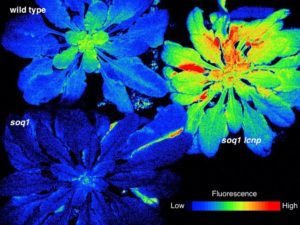After a cold and high light stress, thale-cress plants (wild-type and soq1) display less chlorophyll fluorescence, equivalent to more energy dissipation. Researchers found that mutant plants with deficient levels of the lipocalin protein (soq1 lcnp) display high chlorophyll fluorescence. This indicates that LCNP is required for energy dissipation. (Credit: Alizée Malnoë/Berkeley Lab)
Was this page useful?
Send




